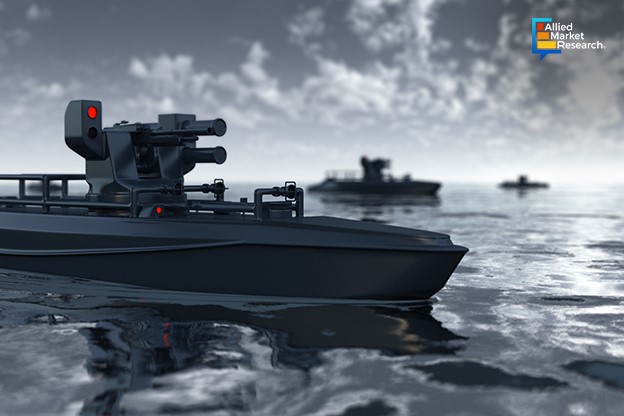Unmanned Surface Vehicles: Can These Autonomous Vessels Bring Broader Scopes for Your Business Expansion?

6 Feb
2024
Highlights:
- Introduction
- Potential applications of USVs
- Role of USVs in the oil & gas industry
- Recent developments in the domain
Over the years, the continuous progress in science and technology has promisingly fulfilled the requirements for marine vehicles in various fields. Unmanned surface vehicles (USVs) have gained huge traction in the marine industry because of their intelligence and autonomous control. These vehicles are also known as autonomous vessels that operate on water surfaces without needing a crew. They are mainly of two types; one is remotely operated vehicles, and the other type is autonomous vehicles. Both types of vehicles can be operated robotically with observational tools such as cameras and sensors. These days, USVs are used for various civilian purposes, including law enforcement, naval operations, climate monitoring, civilian purposes, and several commercial applications. In this article, we will discuss how these advanced vehicles play a significant role in upscaling developing economies.
What applications of USVs can drive businesses with incredible opportunities?
Primarily, USVs are designed to serve as mobile targets for carrying various military various training and defense systems testing on the sea. Many mining teams, anti-piracy forces, and teams for observation and reconnaissance can utilize these vehicles because of their unparalleled properties such as they are powerful, stealthy, and highly agile. Because of the wide capabilities of USVs, the defense and military segment is widely implementing these vehicles for various disciplinary surveillance, and the segment is predicted to hold the lion’s share by generating a revenue of $1140.9 million during 2023-2032.
When it comes to the marine sector, these vehicles have come out to be the most effective and versatile solution. They can be used for multiple missions such as surveying large water areas, monitoring environmental conditions, and collecting data from hard-to-reach locations. To perform all these crucial activities, USVs are equipped with a wide range of sensors and payloads based on the needs of a particular application. Such advanced equipment can enable them to perform the activities independently for a longer period. The vehicles have gained popularity in various naval applications such as mine detection, and anti-submarine warfare.
Moreover, unmanned surface vehicles are widely used for performing hydrographic surveys. Usually, hydrographic surveys require extensive sail time and frequent back-and-forth round turns. This used to cause considerable threats to the health and safety of the surveyor. However, with the help of small USVs, comprising autonomous control systems such as transducers and GPS systems can perform the survey tasks with minimal effort and manpower. All these autonomous systems can further allow operators to perform all hydrographic surveys from land with minimal to low-risk levels.
On the contrary, these vehicles can regulate several industries and help commercial organizations collect data such as counting fish stocks. In this way, they can help reduce overfishing through commercial sea by using modern sensing technologies. Additionally, the growing need for autonomous patrol boats has increased the applicability of USVs. These boats can be used for surveillance in serious conditions requiring precision and endurance. Many maritime and border forces are collaborating to create these autonomous patrol boats for effective surveillance.
Unmanned surface vehicles: A safeguard for the oil and gas industry
The oil & gas industry is a crucial domain where every parameter needs to be crosschecked to ensure safety and security. Unmanned surface vehicles can elevate smooth functionalities in this domain by performing a thorough inspection of various processes associated with the field such as examining oil pipes and rigs, discovering damage during oil spills, and many more. Now, as these vehicles are optimized with autonomous controls, they can make surveillance of all processes efficiently compared to traditional manned vessels. Fugro, a Dutch multinational public company, deployed Blue Essence USV and Blue Volta eROV, two remotely controlled USVs to perform inspections for more than 40km of offshore pipelines. These vehicles can perform multiple activities such as inspecting the depth of burial, making visual inspections, and carrying cathodic protection assessments of pipelines between various offshore platforms.
On the other hand, monitoring flare stacks is one of the hazardous tasks in the oil and gas industry that gets easier with these vehicles. Flare stacks are mainly utilized in rocket launchers to burn off surplus gas during unpredicted over-pressurization. As the stacks require regular monitoring, USVs can serve to maintain these stacks to make a controlled combustion. In such ways, USV technology is highly essential in the oil and gas industry for extensive data collection and making vivid analysis of various undergoing processes.
Mast 13: Recently designed unmanned surface vehicle
In January 2024, CENTCOM, one of the eleven unified combatant commands of the U.S. Department of Defense, displayed the Arabian Fox Mast-13 unmanned surface vessel at the Unmanned Systems Exhibition for the first time. This USV is designed to work with the Navy’s high-tech Task Force 59. According to a US Naval Forces Central Command official, the vehicle is equipped with Starlink, which will enable the USV to maintain long-range command and control through low Earth orbit satellites. He also added that the satellite is going to be operational in the coming two months.
To sum up, the unmanned surface vehicle industry is experiencing significant growth due to the increasing demand for USVs across military and commercial sectors. Moreover, the growing integration of modern technologies such as AI in USVs to enhance their capabilities will bring excellent opportunities for the domain in the future.
To assess the competitive landscape of the unmanned surface vehicle domain and develop new strategies for your business to gain a competitive advantage, feel free to talk to our industry experts today!

Rosy Behera
Author's Bio- Rosy Behera holds a bachelor’s degree in Electrical and Electronics Engineering and now she is a content writer by profession. She loves to portray her thoughts and ideas with a nice command of words. Grabbing an audience with her creative write-ups is one of her biggest assets so far. Apart from writing, she is a certified “Odisi” dancer and has done Gardharva in Drawing, Painting, and Arts. She always explores new things through travel and is a big foodie.
Avenue: Entire Library membership of Allied Market Research Reports at your disposal
- Avenue is an innovative subscription-based online report database.
- Avail an online access to the entire library of syndicated reports on more than 2,000 niche industries and company profiles on more than 12,000 firms across 11 domains.
- A cost-effective model tailored for entrepreneurs, investors, and students & researchers at universities.
- Request customizations, suggest new reports, and avail analyst support as per your requirements.
- Get an access to the library of reports at any time from any device and anywhere.
Related Post
-
How are Submarine Cables Transforming Global Connectivity with Enhanced User Experience?
-
Endoscopy Procedures: Transformations in Techniques and Applications
-
AI-Powered Video Analytics: How the Product Actually Works for enterprises
-
Painting Robots: Transforming Precision Coating and Creative Applications
-
Innovations in Pharmacovigilance Systems Advancing Patient Safety
-
Understanding Edge Security: Keeping Data Safe Near the Source
-
Exploring the Use and Advancements of 3D Laser Scanners in Professional Applications
-
Reinforcing Industrial Controls with Smarter Tools and Training








